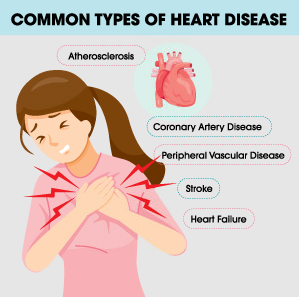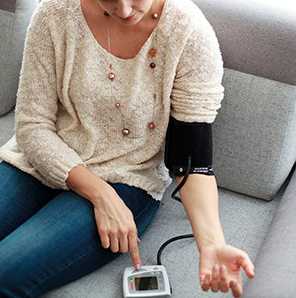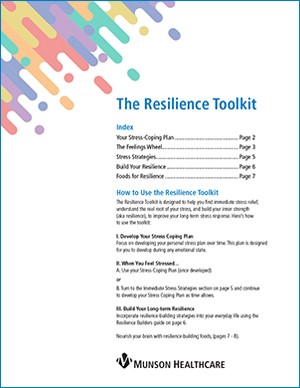For Women: Take This Health Risk to Heart

Heart disease has long been perceived as a disease that need not concern women until menopause. But heart attacks can and do occur at any age. Most women between the ages of 40 and 60 have at least one risk factor for the disease – though many don't realize it. Here are some more facts you may not know about women and heart disease:
- Heart disease is the leading cause of death among women, killing 1 in 3 women each year.
- Heart disease causes more death in women than all types of cancer combined – yet just over 40% of women understand that heart disease is their greatest health threat.
- Almost 45% of women ages 20 and older are living with some form of heart disease.
- Women outpace men in deaths caused by high blood pressure (aka hypertension) and stroke.
- Heart disease is the primary cause of death in new moms, causing 30% of maternal deaths.
- Women care more likely to experience atypical heart attack symptoms that don’t feel as obvious.
(Source: American Heart Association).
In This Heart Health Blog:
- The most common types of heart disease
- Factors that increase women’s risk for heart disease
- Ways to reduce your risk for women’s heart disease
Common Types of Heart Disease
Just like men, women are most threatened by heart disease. But what defines heart disease? There are many forms, including:

Atherosclerosis. When the walls of your arteries thicken and harden due to plaque buildup.
Coronary artery disease (CAD). Caused by plaque buildup specifically in the arteries that supply your heart with blood.
Peripheral vascular disease (PVD). Also known as peripheral artery disease, this disease is also correlated with a buildup of plaque in your blood vessels, which leads to poor blood circulation over time. PVD causes complications in the vessels outside of your heart, such as your legs, and can lead to clotting.
Stroke. When a blood vessel that supplies your brain with blood is unable to do so due to either a blockage (aka a clot) or because the artery itself ruptures.
Heart failure. Occurs when your heart can not pump blood at optimal levels, leading to symptoms like edema and shortness of breath. Heart failure is also known congestive heart failure.
Factors That Lead to Women’s Heart Disease
Are some women more susceptible to heart disease than others? Knowing your risk factors is critical. There are two categories of factors that put you at risk for heart disease: 1) Major risk factors and 2) Factors that lead to an increased risk. The more risk factors you have and the worse they are, the greater your risk for heart disease.
Major Risk Factors | Factors that increase your risk |
High blood pressure | Stress |
High cholesterol | Alcohol consumption (more than one drink a day on average) |
Diabetes | Hysterectomy |
Chronic kidney disease | History of or current use of birth control pills |
Obesity or being overweight | Pregnancy and the high-risk complications of pregnancy, including diabetes, pre-eclampsia, and eclampsia |
Smoking | Being past menopause |
Physical inactivity |
|
Heredity |
|
Age |
|
Once you understand your risk factors, you can learn whether you're at high, intermediate, or low risk for developing heart disease. Do you know your numbers? “Specifically targeting cholesterol levels, blood pressure, and blood sugars are the mainstay for prevention and management,” shares Traverse Heart & Vascular Cardiologist Anna Stone, MD, FACC.
Once you know your numbers and risk factors, you can work with your healthcare provider to set goals and reach them.
Heart-Healthy Lifestyle changes
The following lifestyle changes will put you on the path to a heart-healthy life:
Quit smoking.
The most common risk factor for women, smoking triples your heart attack risk. It may take a few tries to quit – but your body will begin repairing itself within minutes when you do. It is never too late to quit smoking. Talk with your healthcare provider about tools or medicines that can help you quit.
Reach and keep a healthy weight.
Achieving and maintaining a healthy weight helps reduce your risk of heart disease three-fold by decreasing your blood pressure, cholesterol, and risk for diabetes. Excess fat around the belly is especially linked to higher levels of triglycerides – a blood fat that raises your risk for heart disease.
Know your blood pressure.

Starting at age 20, women should know their blood pressure. Check your blood pressure at least one time every 2 years if your blood pressure is less than 120/80. If your blood pressure is higher, your healthcare provider will talk with you about checking it more often. Learn more about why blood pressure matters in this short Munson Minutes segment.
Know your cholesterol levels.
Have your cholesterol levels checked at least every 4 to 6 years. You may need to get them checked more often if you have increased risk factors, such as a family history of heart attacks under the age of 50. One red flag is a high level of LDL ("bad") cholesterol, which clogs arteries, and a low level of HDL ("good") cholesterol, which clears arteries.
Move more.
“Get up and move!” Dr. Stone advises. “I hear many patients, especially since the pandemic, report that they do not exercise and are very sedentary.”
Exercising at a moderate intensity for at least 150 minutes a week can lower your blood pressure while simultaneously strengthening your heart, decreasing your stress, and lowering your weight. According to Stone, you can slowly work up to this goal. “Start off with a small goal, such as a daily 15-minute walk, then move it to a brisk walk, then increase this to twice a day, and you can significantly improve your cardiovascular health.” Adding strength training or resistance exercises two days a week can also increase your metabolism and help maintain a healthy weight.
De-stress daily. Visit a friend. Listen to music. Take a yoga class.
Putting yourself on your to-do list and finding ways to defuse stress will help slow your breathing and heart rate as you lower your blood pressure. Get help beating both immediate and long-term stress with Our Resilience Toolkit, which includes a personalized stress-coping plan.
Treat Your Heart to an Annual Wellness Exam
Do you see your primary care provider at least once a year? An annual wellness check-up or physical is a good starting step for understanding your general heart health, thanks to routine screenings that check your blood pressure, cholesterol levels, risk for diabetes, and more. Schedule your wellness appointment today and ask your provider about additional screenings based on your age and individual risk level.
Need to De-Stress? Get Started with our Resilience Toolkit

This resilience toolkit can guide you through your stress from start to finish. Included in the toolkit
- Vocabulary to help identify your real feelings
- A worksheet to help build your personal stress-reduction plan
- Ideas for healthy coping strategies that you can practice anywhere
- Long-term resilience builders, including food!